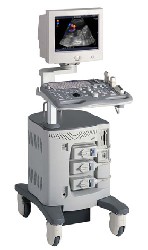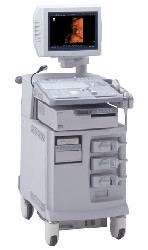Medical Ultrasound Imaging
Sunday, 19 May 2024
'Display' p4 Searchterm 'Display' found in 81 articles 1 term [ • ] - 80 definitions [• ] Result Pages : •
2D ultrasound imaging is a widely used technique in medical imaging that provides two-dimensional visual representations of internal structures. A handheld device known as a probe or transducer contains piezoelectric crystals that emit and receive ultrasound waves which penetrate tissues and bounce back as echoes. The echoes are detected and converted into electrical signals. These signals are processed and displayed on a monitor, creating a real-time 2D grayscale image, with different shades of gray representing various tissue densities. The brighter areas on the image correspond to structures that reflect more ultrasound waves, while darker areas represent structures that reflect fewer waves or are attenuated by intervening tissues. The 2D-mode (or B-mode) provides cross-sectional views of the scanned area, showing a single plane or slice of the scanned area at a time. Key Features and Uses of 2D Ultrasound: •
•
2D ultrasound is excellent for visualizing anatomical structures and detecting anomalies. It is widely used in obstetrics, gynecology, abdominal imaging and vascular examinations.
•
Due to its real-time capabilities, 2D ultrasound is utilized to guide various procedures, including biopsies, injections, and catheter insertions.
•
2D sonography can incorporate Doppler technology to assess blood flow in vessels, aiding in the diagnosis of vascular conditions and evaluating fetal circulation.
Comparison with 3D and 4D Ultrasound: •
Unlike 2D ultrasound, which generates a series of 2D images, 3D ultrasound creates a three-dimensional volume of the scanned area. This allows for more detailed visualization of complex structures, such as fetal facial features or organ morphology.
•
4D ultrasound adds the dimension of time to 3D imaging, resulting in dynamic three-dimensional videos. It enables the visualization of fetal movements and provides a more immersive experience. However, a 4D sonogram is not typically used for diagnostic purposes and is often employed in baby ultrasound examinations for bonding and enjoyment purposes.
See also Ultrasound Technology, Sonographer, Ultrasound Elastography, Obstetric and Gynecologic Ultrasound. •
The 2D-mode (2-Dimensional-mode) is a spatially oriented B-mode (brightness) ultrasound. The imaged structures are displayed 2 dimensional as a function of depth and width. The brightness level is based on the echo signal amplitude. Most of the ultrasound devices in medical imaging are 2D real-time scanner. The image is created by a rapidly back and forth swept sound beam over the region of interest. See also Gray Scale. Further Reading: News & More:
•  From ALOKA Co., Ltd.;
From ALOKA Co., Ltd.;'A Platform for Digital, Pure-Beam Imaging The high-performance, ALOKA ProSound SSD-3500 utilizes advanced ProSound technologies including: Fully digital beam former A wide dynamic range, 12-bit A/D converter Multi beam processing. The SSD-3500 also helps you achieve more efficient examinations. Its ergonomic, user-friendly design enables you to customize the system according to your specific application needs.'
Device Information and Specification
APPLICATIONS
CONFIGURATION
Compact, portable, dual dynamic display
Color Flow, Power Flow, Spectral Doppler, Real-time Free Angular M-Mode, Tissue Harmonic Imaging, Quint Frequency Imaging, Pure Harmonic Detection
STORAGE, CONNECTIVITY, OS
Data Management Subsystem (iDMS), DICOM-Worklist
DATA PROCESSING
12-bit analog to digital converter
•  From ALOKA Co., Ltd.;
From ALOKA Co., Ltd.;'The ProSound SSD-4000 utilizes the most advanced acoustic technologies available today, and its multidisciplinary technology architecture enables it to offer great versatility and flexibility over a wide range of clinical applications. With its new-generation, front-end technology including a 12-bit A/D converter, the ProSound SSD-4000 offers superior contrast resolution−especially when compared to 10-bit systems.'
Device Information and Specification
APPLICATIONS
CONFIGURATION
Compact, portable, dual dynamic display
Wide-band super high-density (W-SHD) transducers
OPTIONAL PACKAGE
Volume Mode
STORAGE, CONNECTIVITY, OS
Data Management Subsystem (iDMS), DICOM-Worklist
DATA PROCESSING
•
Echoes of deep lying structures within the body do not always come from the latest emitted sound pulse and can produce an aliasing artifact. Aliasing lowers the frequency components when the pulse repetition frequency is less than 2 times the highest frequency of a Doppler signal. This artifact can be problematical at Spectral or Color Doppler examinations. Aliasing of the data displayed in pulsed wave technology is utilized as a benefit in determining transitions from laminar to turbulent flow. See also Ultrasound Imaging Modes. Result Pages : |
Medical-Ultrasound-Imaging.com
former US-TIP.com
Member of SoftWays' Medical Imaging Group - MR-TIP • Radiology TIP • Medical-Ultrasound-Imaging
Copyright © 2008 - 2024 SoftWays. All rights reserved.
Terms of Use | Privacy Policy | Advertise With Us
former US-TIP.com
Member of SoftWays' Medical Imaging Group - MR-TIP • Radiology TIP • Medical-Ultrasound-Imaging
Copyright © 2008 - 2024 SoftWays. All rights reserved.
Terms of Use | Privacy Policy | Advertise With Us
[last update: 2023-11-06 01:42:00]




